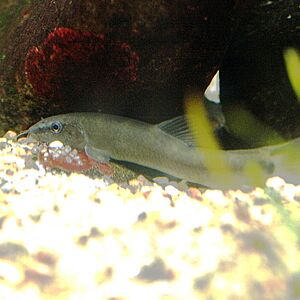Ayumodoki facts for kids
Quick facts for kids Ayumodoki |
|
|---|---|
 |
|
| Conservation status | |
| Scientific classification | |
| Synonyms | |
|
The ayumodoki or kissing loach (Parabotia curtus) is a type of ray-finned fish. It belongs to the Botiidae family. This fish is found in lakes and streams on Honshu, which is the largest island in Japan.
Kissing loaches lay their eggs in early summer. They use special places like ditches and small ponds used for growing rice. These areas are called paddy fields. The fish swim into these flooded areas to spawn. These flooded spots are created when water from mountain streams or irrigation ponds covers dry land. This forms temporary wetlands. After growing up in these flooded fields, adult kissing loaches move to fast-moving, muddy rivers. An example is the Yodo River.
Contents
What Does It Look Like?
The kissing loach has a long body. Its back is a deep dark brown. Its sides have lighter brown stripes that go up and down. Its head is flat and pointed at the front. It has six whiskers, called barbels, under its head near its mouth.
These fish have large gill openings. Their tail fin is moderately forked and has dark stripes. Their pectoral fins (fins near the chest) are rounded. They also have a special line on their side, called a lateral line. This line helps them sense things in the water. It starts near their gill cover and goes all the way to the base of their tail fin.
How Do Baby Loaches Grow?
Scientists have studied how kissing loaches develop when they are very young. They looked at how the eggs hatch and how the baby fish, called larvae, move towards the water surface. The places where these fish lay eggs are often covered with plants. These plants get flooded with water for rice farming during the spawning season in early summer.
Baby loaches hatch in these flooded areas. They need to grow quickly because these flooded fields and ditches might only stay wet for a few days. For example, some loaches migrate from rivers like the Yoshii River in June to spawn in these temporary spots.
What Do They Eat?
When Parabotia curtus are young, they stay in the paddy fields where they hatched. Tiny creatures called water fleas are a big food source for them. Other young fish in these areas also eat water fleas.
Once young loaches move to rivers, their mouths are fully developed for suction. They use their barbels, or whiskers, to search the muddy river bottom. They look for things like detritus (tiny bits of dead plants and animals), mud worms, and other small creatures.
Why Are They Endangered?
The kissing loach is listed as critically endangered by the International Union for the Conservation of Nature (IUCN) Red List. This means they are at a very high risk of disappearing forever.
One big reason is that Japan is growing quickly. More land is being used for cities and buildings. This urbanization is destroying important river ecosystems. These ecosystems are crucial habitats for many fish species, including the protected kissing loach.
Many environmental groups are working with the Japanese government. They want to protect and expand these important natural areas. This helps prevent the destruction of the few remaining habitats where fish like the kissing loach can spawn.
For example, in 2012, the Kameoka city government planned to build a city park with a sports stadium. Environmental groups pointed out that the planned location would destroy a vital spawning ground for young fish. Building there could also cause flooding in other areas. Because of these concerns, in 2016, the city decided to move the stadium to a different location. This helped protect the last natural loach habitats in Japan.


